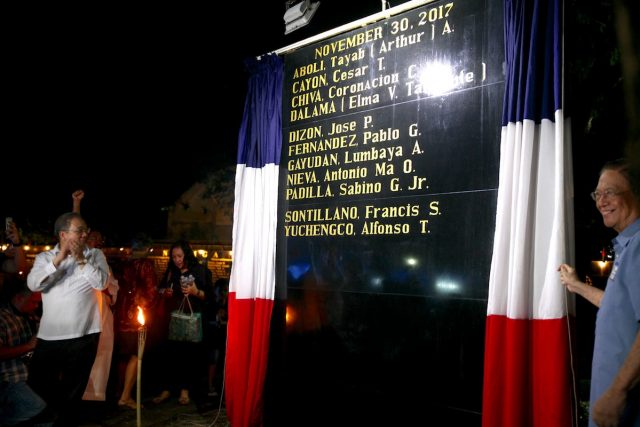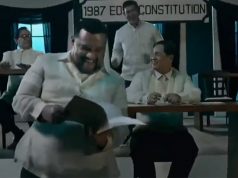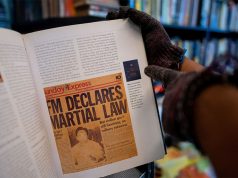
MANILA – The 154th birth anniversary of Andres Bonifacio on Thursday (Nov. 30) provided the best context for the Bantayog ng Mga Bayani rites honoring 2017’s batch of martial law martyrs and heroes, but it also showed up the biggest irony of the times: as 11 names of those who rebelled, with or without arms, against the Marcos dictatorship were inscribed on the Wall of Remembrance, pro-Duterte groups marched at Mendiola, prodding a sitting president to declare a “revolutionary government.”
Thus, it was not unexpected that the main speaker at the Bantayog rites, former detainee and now Mapua University president and CEO Reynaldo B. Vea, would warn of the “real danger of historical amnesia or worse, revisionism” – of the type that activists said would surely make Bonifacio, founder of the Katipunan that led the 1896 Philippine Revolution which freed Filipinos from more than three centuries of Spanish colonialism, “turn in his grave.”
Many in the crowd who showed up Thursday at the Bantayog rites showed the ravages both of age and of their shared experiences during the dictatorship, lamenting the current regime’s soft disposition for the Marcoses – Ferdinand Marcos was buried at the Libingan ng mga Bayani amid massive protests one year ago – as well as for its supporters’ push for a “revolutionary government” that would render irrelevant the 1987 Constitution that had been forged with an obvious intent to prevent an easy repeat of the dictatorship.
This year’s batch of 11 martyrs and heroes showed the diversity of the people and groups who set aside their differences and made possible the 1986 EDSA Revolt that sent the Marcoses into exile.
Twenty years after his death while heading (as the first Asian) the Prague-based International Organization of Journalists (IOJ), writer-labor leader Antonio Ma. Onrubia Nieva was finally inscribed at the Bantayog’s granite wall. The founding chairman of the National Union of Journalists of the Philippines (post-EDSA) and the president of the National Press Club (NPC) in the twilight years of the dictatorship, Nieva was arrested and detained by the Marcos military in 1983 after a raid on his apartment in Manila. Unfazed, he continued his militant writing and media union organizing, and would subsequently use the NPC, during his presidency from 1984-1986, as haven for harassed journalists at a time when pressure was building up on the dictatorship which in turn clamped down harder on activists and the press.

Also honored at the Bantayog was billionaire-philanthropist Alfonso Yuchengco, who, at great risk to his family’s business, gave quiet support to anti-dictatorship groups, particularly the Light A Fire Movement. After the EDSA Revolt, he was named ambassador to China, then Japan and the United Nations.
Then, there was a priest: Fr. Jose Dizon, who died of natural causes in 2013, had worked alongside workers and militant church people resisting the dictatorship. Even after the EDSA Revolt, Fr. Joe continued to support the work of those resisting attempts to damage the constitutional democracy built with so much sacrifice by thousands. In 2005, it was Fr. Joe whom beleaguered NBI deputy director Sammy Ong would turn to for support while he was at risk of arrest for his role in helping expose the “Hello, Garci” election fraud scandal that almost brought down then-President Gloria Macapagal Arroyo.
Some of those in this year’s batch had taken up arms against the dictatorship:
– Coronacion Chiva of Iloilo, a Hukbalahap member who fought the Japanese in World War II and later became the NPA’s “Kumander Waling Waling”;
– Cesar T. Cayon of Davao, who worked alongside the Higaonons in Mindanao and was beheaded by his military captors
– Tayab Arthur Aboli, a Kalinga leader
– Dalama Elma Villaron of the Tumandok tribe in Panay.
Also inscribed on the Bantayog’s granite wall of remembrance were the names of:
– University professor Sabino G. Padilla who fought for the cause of Navotas fish workers and Isabela farmers threatened by a powerful landgrabber.
– Lumbaya Gayudan, kalinga tribal leader who led the opposition to the Chico River dam project after the revered chieftain Macli-ing Dulag was killed.
– Pablo G. Fernandez, political activist who as Army reservist refused to be deployed to fight the Moro people and later joined the rebels.
– Francis Sontillano, A Philippine Science High School scholar who died at age 15.
Former senator Wigberto “Bobby” Tañada, who chairs the Bantayog ng mga Bayani Foundation, led guests in unveiling the new granite slab on which were etched the 11 martyrs’ names. Before that, he had expressed hope the continuing exercise of searching for and documenting the lives and work of those who fought the dictatorship would turn back the tide of amnesia on such a crucial chapter in history.
Tañada’s father Lorenzo, who as opposition senator was also detained by Marcos, and who had coaxed the then corporate lawyer Bobby to join the thin ranks of human rights lawyers during the dictatorship, is among the earlier batch of Bantayog martyrs.
There are now 298 names inscribed at the Bantayog monument. – Reports by B. Testa, LM Fernandez, InterAksyon









